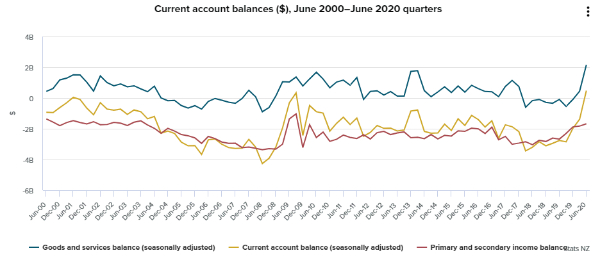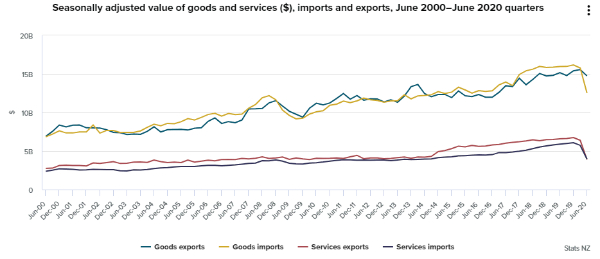Fall In Imports Drives Current Account Surplus
New Zealand’s COVID-19 lockdown saw imports fall more than exports, leading to a record current account surplus of $0.5 billion in the June 2020 quarter, Stats NZ said today.
“New Zealand earned more than it spent in transactions with the rest of the world due to a sharp slowdown in international trade because of COVID-19,” international statistics senior manager Peter Dolan said.
“This reflects a slump in demand for oil imports and in spending by international tourists, while dairy exports held up in the June quarter, boosting the current account into the black.”
New Zealand’s seasonally adjusted current account surplus of $0.5 billion in the June 2020 quarter is the biggest in the series since 1971, and compares with a $1.4 billion deficit in the March 2020 quarter.
“A current account surplus occurs when New Zealand’s earnings from the rest of the world from exports, income on investments, and secondary income are larger than our expenses to the rest of the world,” Mr Dolan said.
“This is only the 11th quarterly seasonally adjusted current account surplus in the series. New Zealand typically runs a deficit, spending more than we earn – the last time we had a surplus was 11 years ago.”

The current account surplus was driven by the goods balance turning from a deficit into a $2.2 billion surplus. Exports fell $0.8 billion in the quarter but imports fell much more, down $3.2 billion.

“Domestic demand for crude oil imports fell as people stayed home due to the COVID-19 lockdown in the first half of the June quarter,” Mr Dolan said.
“Crude oil imports were much lower than usual from April to June 2020, with much less travel by road and air. Oil imports fell to zero in July, just after the end of the June 2020 quarter. With only essential businesses allowed to operate during alert levels 3 and 4, wholesale and manufacturing trade also shrank, reducing the imports required for production and further hitting related suppliers.”
See Crude oil imports dry up in July and Manufacturing and wholesale trade: June 2020 quarter for further information.
Services balance in deficit
New Zealand’s services balance was in deficit for the first time since the September 1998 quarter.
Exports of services were $3.9 billion in the June 2020 quarter, down $2.5 billion from the March 2020 quarter. Travel services were $2 billion for the quarter, down 48 percent (or $1.9 billion), after the border was closed to overseas visitors.
Imports of services were also down in the June 2020 quarter, by $1.8 billion. At $4 billion it is the smallest quarterly value since the March 2014 quarter.
“Overseas tourist spending on travel and transportation services took a big hit in the latest quarter as border crossings were restricted. However, there were still international visitors in the country from before the lockdown and the limited number of flights increased the cost of transporting freight,” Mr Dolan said.
See COVID-19 knocks spending by overseas visitors and students, Export prices hit new high and the New Zealand International Trade dashboard for further information.
For the year to June 2020 the current account deficit was $5.8 billion, or 1.9 percent of gross domestic product (GDP). This compares to $11.6 billion (3.8 percent of GDP) for the year to June 2019. This is the smallest the current account has been as a percentage of GDP since the year ended June 2010, when it was 1.7 percent of GDP.


 SolarZero: SolarZero Limited (in Liquidation) - Important Business Update
SolarZero: SolarZero Limited (in Liquidation) - Important Business Update Science Media Centre: Cyclone Gabrielle's Impacts On NZ's Ecosystems - Expert Reaction
Science Media Centre: Cyclone Gabrielle's Impacts On NZ's Ecosystems - Expert Reaction RNZ: Parts Of Power System Could Be Out For 36 Hours In Event Of Extreme Solar Storm
RNZ: Parts Of Power System Could Be Out For 36 Hours In Event Of Extreme Solar Storm NZAS: New Zealand Association Of Scientists Awards Celebrate The Achievements Of Scientists And Our Science System
NZAS: New Zealand Association Of Scientists Awards Celebrate The Achievements Of Scientists And Our Science System Stats NZ: Retail Spending Flat In The September 2024 Quarter
Stats NZ: Retail Spending Flat In The September 2024 Quarter Antarctica New Zealand: International Team Launch Second Attempt To Drill Deep For Antarctic Climate Clues
Antarctica New Zealand: International Team Launch Second Attempt To Drill Deep For Antarctic Climate Clues



